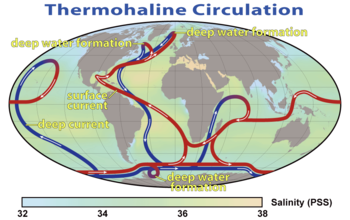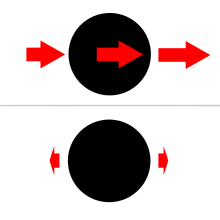From Wikipedia, the free encyclopedia
An ideal gas is a theoretical gas composed of many randomly moving point particles whose only interactions are perfectly elastic collisions. The ideal gas concept is useful because it obeys the ideal gas law, a simplified equation of state, and is amenable to analysis under statistical mechanics.
One mole of an ideal gas has a volume of 22.710947(13) litres[1] at STP (a temperature of 273.15 K and an absolute pressure of exactly 105 Pa) as defined by IUPAC since 1982. (Until 1982, STP was defined as a temperature of 273.15 K and an absolute pressure of exactly 1 atm. The volume of one mole of an ideal gas at this temperature and pressure is 22.413962(13) litres.[2] IUPAC recommends that the former use of this definition should be discontinued;[3] however, some textbooks still use these old values.)
At normal conditions such as standard temperature and pressure, most real gases behave qualitatively like an ideal gas. Many gases such as nitrogen, oxygen, hydrogen, noble gases, and some heavier gases like carbon dioxide can be treated like ideal gases within reasonable tolerances.[4] Generally, a gas behaves more like an ideal gas at higher temperature and lower pressure,[4] as the potential energy due to intermolecular forces becomes less significant compared with the particles' kinetic energy, and the size of the molecules becomes less significant compared to the empty space between them.
The ideal gas model tends to fail at lower temperatures or higher pressures, when intermolecular forces and molecular size become important. It also fails for most heavy gases, such as many refrigerants,[4] and for gases with strong intermolecular forces, notably water vapor. At high pressures, the volume of a real gas is often considerably greater than that of an ideal gas. At low temperatures, the pressure of a real gas is often considerably less than that of an ideal gas. At some point of low temperature and high pressure, real gases undergo a phase transition, such as to a liquid or a solid. The model of an ideal gas, however, does not describe or allow phase transitions. These must be modeled by more complex equations of state. The deviation from the ideal gas behaviour can be described by a dimensionless quantity, the compressibility factor, Z.
The ideal gas model has been explored in both the Newtonian dynamics (as in "kinetic theory") and in quantum mechanics (as a "gas in a box"). The ideal gas model has also been used to model the behavior of electrons in a metal (in the Drude model and the free electron model), and it is one of the most important models in statistical mechanics.
Types of ideal gas
There are three basic classes of ideal gas[citation needed]:- the classical or Maxwell–Boltzmann ideal gas,
- the ideal quantum Bose gas, composed of bosons, and
- the ideal quantum Fermi gas, composed of fermions.
Classical thermodynamic ideal gas
Macroscopic account
The ideal gas law is an extension of experimentally discovered gas laws. Real fluids at low density and high temperature approximate the behavior of a classical ideal gas. However, at lower temperatures or a higher density, a real fluid deviates strongly from the behavior of an ideal gas, particularly as it condenses from a gas into a liquid or as it deposits from a gas into a solid. This deviation is expressed as a compressibility factor.The classical thermodynamic properties of an ideal gas can be described by two equations of state:.[5][6]
One of them is the well known ideal gas law
- P is the pressure
- V is the volume
- n is the amount of substance of the gas (in moles)
- R is the gas constant (8.314 J·K−1·mol−1)
- T is the absolute temperature.
- k is a constant used in Boyle's law
- b is a proportionality constant; equal to V/T
- a is a proportionality constant; equal to V/n.
.
;
.
- U is the internal energy
- ĉV is the dimensionless specific heat capacity at constant volume, approximately 3/2 for a monatomic gas, 5/2 for diatomic gas, and 7/2 for more complex molecules.
Microscopic model
In order to switch from macroscopic quantities (left hand side of the following equation) to microscopic ones (right hand side), we use- N is the number of gas particles
- kB is the Boltzmann constant (1.381×10−23 J·K−1).
The ideal gas model depends on the following assumptions:
- The molecules of the gas are indistinguishable, small, hard spheres
- All collisions are elastic and all motion is frictionless (no energy loss in motion or collision)
- Newton's laws apply
- The average distance between molecules is much larger than the size of the molecules
- The molecules are constantly moving in random directions with a distribution of speeds
- There are no attractive or repulsive forces between the molecules apart from those that determine their point-like collisions
- The only forces between the gas molecules and the surroundings are those that determine the point-like collisions of the molecules with the walls
- In the simplest case, there are no long-range forces between the molecules of the gas and the surroundings.
Heat capacity
The heat capacity at constant volume, including an ideal gas is:The heat capacity at constant pressure of 1/R mole of ideal gas is:
Sometimes, a distinction is made between an ideal gas, where ĉV and ĉP could vary with temperature, and a perfect gas, for which this is not the case.
The ratio of the constant volume and constant pressure heat capacity is
Entropy
Using the results of thermodynamics only, we can go a long way in determining the expression for the entropy of an ideal gas. This is an important step since, according to the theory of thermodynamic potentials, if we can express the entropy as a function of U (U is a thermodynamic potential), volume V and the number of particles N, then we will have a complete statement of the thermodynamic behavior of the ideal gas. We will be able to derive both the ideal gas law and the expression for internal energy from it.Since the entropy is an exact differential, using the chain rule, the change in entropy when going from a reference state 0 to some other state with entropy S may be written as ΔS where:
This is about as far as we can go using thermodynamics alone. Note that the above equation is flawed — as the temperature approaches zero, the entropy approaches negative infinity, in contradiction to the third law of thermodynamics. In the above "ideal" development, there is a critical point, not at absolute zero, at which the argument of the logarithm becomes unity, and the entropy becomes zero. This is unphysical. The above equation is a good approximation only when the argument of the logarithm is much larger than unity — the concept of an ideal gas breaks down at low values of V/N. Nevertheless, there will be a "best" value of the constant in the sense that the predicted entropy is as close as possible to the actual entropy, given the flawed assumption of ideality. A quantum-mechanical derivation of this constant is developed in the derivation of the Sackur–Tetrode equation which expresses the entropy of a monatomic (ĉV = 3/2) ideal gas. In the Sackur–Tetrode theory the constant depends only upon the mass of the gas particle. The Sackur–Tetrode equation also suffers from a divergent entropy at absolute zero, but is a good approximation for the entropy of a monatomic ideal gas for high enough temperatures.
Thermodynamic potentials
Expressing the entropy as a function of T, V, and N:.
In statistical mechanics, the relationship between the Helmholtz free energy and the partition function is fundamental, and is used to calculate the thermodynamic properties of matter; see configuration integral for more details.
Speed of sound
The speed of sound in an ideal gas is given by- γ is the adiabatic index (ĉP/ĉV)
- s is the entropy per particle of the gas.
- ρ is the mass density of the gas.
- P is the pressure of the gas.
- R is the universal gas constant
- T is the temperature
- M is the molar mass of the gas.
Ideal quantum gases
In the above-mentioned Sackur–Tetrode equation, the best choice of the entropy constant was found to be proportional to the quantum thermal wavelength of a particle, and the point at which the argument of the logarithm becomes zero is roughly equal to the point at which the average distance between particles becomes equal to the thermal wavelength. In fact, quantum theory itself predicts the same thing. Any gas behaves as an ideal gas at high enough temperature and low enough density, but at the point where the Sackur–Tetrode equation begins to break down, the gas will begin to behave as a quantum gas, composed of either bosons or fermions. (See the gas in a box article for a derivation of the ideal quantum gases, including the ideal Boltzmann gas.)Gases tend to behave as an ideal gas over a wider range of pressures when the temperature reaches the Boyle temperature.















![{\displaystyle {\frac {S}{Nk}}=\ln \left[{\frac {V}{N}}\,\left({\frac {U}{{\hat {c}}_{V}kN}}\right)^{{\hat {c}}_{V}}\,{\frac {1}{\Phi }}\right]}](https://wikimedia.org/api/rest_v1/media/math/render/svg/65d5055ff166a2ab540fb032ec1d0ace534b5966)

















































